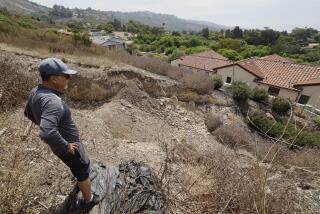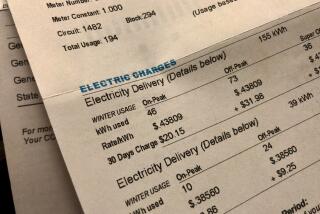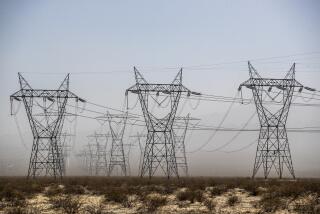VIEWPOINTS : Utilities Plug Into Electromagnetic Field Issue
Chief executives of electric utilities have been bombarded by a seemingly endless number of environmental issues--global warming and nuclear meltdowns, to name two--that threaten business-as-usual planning.
But the issue that really makes them sweat and reach for the liquor bottle is EMF. Those three letters stand for electromagnetic fields. Although such fields exist in all homes because of electric wiring and enter our daily lives when we use the dishwasher, hair dryer or TV, the issue is emerging as the utility environmental issue of the 1990s. The reason: fears of increased cancer risk for those who live near power lines.
Although studies remain inconclusive, utilities are beginning to take steps to deal with an issue that not only could result in expensive lawsuits but also could thwart the expansion of the electric grid to new customers. In short, the issue could bring back an era of energy self-sufficiency for those regions of the country not hooked up to the grid, a scenario that a Luddite could love but that gives utility CEOs a bad case of indigestion.
At a recent conference on the subject in San Francisco, nervous utility representatives from throughout the country shared EMF strategies. The underlying message: honest communication.
Worried that the EMF problem could spur a not-in-my-backyard response that could jeopardize power delivery and jobs, utilities are trying to cope by learning new public relations skills, such as how to talk to your everyday ordinary Joe and Jill without the aid of slick slide presentations. “I know a lot of us engineer types spent an inordinate amount of energy trying to come up with all kinds of devices that allowed us to not talk with somebody,” said John Moore, head of the Austin, Tex., public utility. “We have to get more comfortable talking with people.”
Among the moves the Austin utility has undertaken is hiring people from outside the utility with high credibility in the community to take the lead on the issue. The utility is, like others in Seattle, Los Angeles and elsewhere, sharing EMF measurement and health study data with its customers. It is also highlighting the safety and reliability trade-offs that exist in a decision to build or not to build new transmission lines.
The underlying theme of the conference was that utilities need to learn how to gain credibility by involving the public in the decision-making process. As one panelist noted: “If EMF is not a problem, then why not involve the public? Give them reasons to approve the project instead of denying it.”
To date, only Florida and New York have adopted EMF standards for power lines. A representative from a Florida utility recently estimated that it would cost the state’s utilities $50 billion to upgrade the entire state’s transmission system to the approved standards. The cost for new lines was just $5 billion. These funds, if they are indeed required to be spent, would probably come from state ratepayers. Such costs could become persuasive ammunition in future debates over EMF.
The cost of potential lawsuits from mothers worried about the health of children playing or living near power lines might even bankrupt some utilities.
Although California has yet to approve standards, the state’s utilities are funding a state Department of Health Services study on the health impacts of EMF. In addition, state Sen. Herschel Rosenthal (D-Los Angeles) plans to introduce a bill this session that would, among other things, outline some modest “prudent avoidance” techniques to mitigate possible effects of EMF.
Perhaps the most memorable speaker at the San Francisco conference was Cindy Sage. She is a mother of two who helped develop a low-cost “prudent avoidance” program in conjunction with Southern California Edison and the California Department of Health Services for Montecito Union School in Santa Barbara County.
After a study showed cancer clusters five times the predicted rate for the vicinity, local citizens became very concerned and began pulling their children from the Montecito school. After a Health Services report, released in December of 1989, was discredited because EMF measurements were taken on a Sunday--when electric loads were low--Sage stepped in to organize a credible analysis.
An environmental and land-use consultant who had been involved with EMF issues since 1980, Sage persuaded SoCal Edison to fund a $17,000 independent study. Using the data from this study, hot spots on school property were identified. (The school is adjacent to a substation, and a 66,000-volt line bisects the school.)
Despite delays in the final draft of the Health Services report, released last month, Sage used the independent database generated by the utility-funded study to help devise a mitigation program at very little additional expense to SoCal Edison. Certain hot-spot playground areas were roped off, for instance. “We wanted to protect the children without having to win a lawsuit,” Sage said.
Sage feels that the Health Services Department should adopt interim EMF standards and embark upon a prudent avoidance strategy modeled after the Montecito Union School experience.
Others worry about using interim standards, fearing that the public would become mistrustful of government regulators if the standard were reduced in the future.
No matter what happens, the EMF issue demonstrates that a new era of utility public relations will test the tenets of democratic decision making in the public utility regulation arena. Apparently we cannot wait for a definitive answer on the health effects of EMF.
In this era of environmentalism, utilities as well as other businesses need to learn how to respond effectively to public concerns and to include the public as stake holders in future decision making. With the stakes so high on both sides, it makes sense to start by talking.
More to Read
Inside the business of entertainment
The Wide Shot brings you news, analysis and insights on everything from streaming wars to production — and what it all means for the future.
You may occasionally receive promotional content from the Los Angeles Times.










